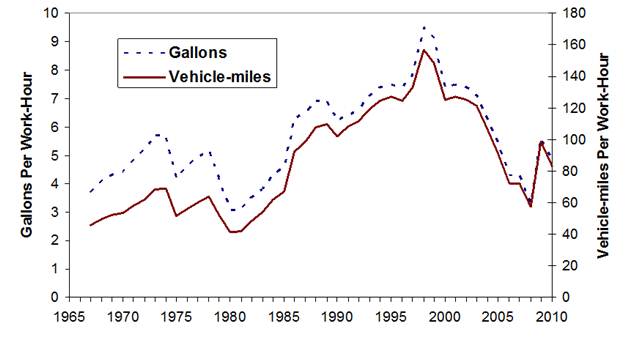Bad planning simply extrapolates past trends: “We experienced 2% annual growth during the last decade, so we’ll assume that will continue into the future.” Good planning attempts to understand underlying factors that affect change.
Bad planning simply extrapolates past trends: "We experienced 2% annual growth during the last decade, so we'll assume that will continue into the future." Good planning attempts to understand underlying factors that affect change. Such is the case with the price elasticity of vehicle travel, that is, the changes in vehicle travel caused by a change in transport prices (fuel, parking, tolls, insurance, etc.).
A few years ago, studies by Small and Van Dender (2007) and Hughes, Knittel and Sperling (2006) found that in the U.S. between about 1970 and 2000, fuel prices had declining impacts on vehicle travel and fuel consumption. This research found price elasticities under -0.1 for vehicle travel and -0.2 for fuel (a 10% fuel price increase causes vehicle travel to decline 1% and fuel consumption to decline 2%), leading many experts to conclude that transport pricing reforms are ineffective ways to achieve planning objectives, and rebound effects (the additional vehicle travel that results from increases in fuel economy) are not very significant. These finding have been widely repeated and incorporated into various types of analyses, such as evaluations of energy conservation and emission reduction strategy evaluations.
These studies were valid. All evidence indicates that during that period vehicle travel became less sensitive to price. But it is inappropriate to apply their results to analyses of future impacts without accounting for demographic and economic trends. If you investigate the underlying factors that affect travel demands I think you will agree that the low elasticity values measured during that period resulted from unique demographic and economic conditions that are unlikely to occur in the future.
Between 1970 and 2000 driving costs declined significantly relative to incomes due to a combination of declining real (inflation adjusted) fuel prices, rising incomes and increased vehicle fuel economy, as illustrated in the following graph. It shows that between 1980 and 2000, the average number of vehicle-miles purchased per work-hour more than tripled from about 40 to about 140. Driving became cheap!
Fuel and Vehicle Travel Purchased Per Median Worker Hour

Between 1980 and 2000 the number of miles that an average worker could purchase per hour more than tripled. It subsequently declined due to stagnant wages and increased real fuel prices.
But as the graph illustrates, after 2000 the number of miles purchased per work-hour declined significantly. As a result, a percentage change in fuel price now represents a much larger percentage of incomes and household budget.
Also during this period the portion of adults employed outside the home increased as more women entered the workforce, causing both incomes and travel demands to increase, and our transportation system became more automobile-dependent due to more sprawled development and declines in walking, cycling and public transit. Those factors tended to reduce the price sensitivity of driving (a typical household had two commuters located in an automobile-dependent suburban home - it was essentially addicted to fuel).
These trends have started to reverse. Per capita incomes have stagnated and employment rates have started to decline as Baby Boomers retire, consumers are choosing more accessible home locations, and investments in alternative modes are starting to pay off with increases in walking, cycling and public transit travel, as discussed in my report, The Future Isn't What It Used To Be.
As a result, it is unsurprising that recent analyses indicate that price elasticities have increased back to the "normal" levels measured at other times and places. Studies by Boilard (2010), Brand (2009), Gillingham (2010) and Li, Linn and Muehlegger (2011) indicate that the elasticities of vehicle travel with regard to fuel price is -0.2 to -0.3, and the long-run elasticity of fuel consumption with respect to fuel price is -0.4 to -0.8. This is two or three times higher than many current models assume.
Similarly, recent experience with road pricing indicates that relatively modest tolls (such as 5-15 cents per vehicle-mile) can significantly reduce vehicle travel on a roadway, particularly on corridors with high quality public transit services, indicating that pricing can be an effective way to reduce traffic congestion, but cannot fully finance major highway expansions.
There is little reasons to believe that the cost of driving relative to incomes will decline back to the very low levels experienced in the 1980s and 90s. Incomes are stagnant and oil prices are projected to increase as production declines and international demand increases. I believe that policy analysis and planners should not apply the very low price elasticity values recorded in the past for evaluating future pricing impacts.
This has important implications for policy and planning. It indicates that pricing reforms (road tolls, parking pricing, fuel price increases and distance-based pricing) are likely to be more effective at reducing travel demand than conventional models predict, and that fuel efficiency standards will provide less energy savings and emission reductions, and induce more travel and associated costs, than usually assumed. It also indicates that pricing reforms can provide greater benefits and impose smaller costs on consumers (less consumer surplus loss), and that toll roads will generate less revenue than experts often assume. This is good news for planners because it expands the range of solutions that we can apply to transport problems such as congestion, traffic risk, oil dependency and air pollution.
This research is discussed in more detail in my report, Changing Vehicle Travel Price Sensitivities: The Rebounding Rebound Effect. This is a reminder that planners should always try to understand the factors that affect trends.
What do you think? Should transport pricing play a larger role in addressing planning objectives?
For More Information
François Boilard (2010), "Gasoline Demand In Canada: Parameter Stability Analysis," EnerInfo, Vol. 15, No. 3, Fall 2010, Centre for Data and Analysis in Transportation, Université Laval (www.cdat.ecn.ulaval.ca); at www.cdat.ecn.ulaval.ca/english/enerInfo-en/enerinfoen-v15n3.pdf.
Dan Brand (2009), Impacts of Higher Fuel Costs, Federal Highway Administration, (www.fhwa.dot.gov); at www.fhwa.dot.gov/policy/otps/innovation/issue1/impacts.htm.
CBO (2008), Effects of Gasoline Prices on Driving Behavior and Vehicle Markets, Congressional Budget Office (www.cbo.gov); at www.cbo.gov/ftpdocs/88xx/doc8893/01-14-GasolinePrices.pdf.
Kenneth Gillingham (2010), Identifying the Elasticity of Driving: Evidence from a Gasoline Price Shock in California, Stanford University (www.stanford.edu); at www.stanford.edu/~kgilling/Gillingham_IdentifyingElasticityofDriving.pdf.
Kent M. Hymel, Kenneth A. Small and Kurt Van Dender (2010), "Induced Demand And Rebound Effects In Road Transport," Transportation Research B (www.elsevier.com/locate/trb), Vol. 44, Issue 10, December, pp. 1220-1241; at www.socsci.uci.edu/~ksmall/Rebound_congestion_27.pdf.
Shanjun Li, Joshua Linn and Erich Muehlegger (2011), Gasoline Taxes and Consumer Behavior, Stanford (http://economics.stanford.edu); at http://economics.stanford.edu/files/muehlegger3_15.pdf.
Todd Litman (2005), "Efficient Vehicles Versus Efficient Transportation: Comparing Transportation Energy Conservation Strategies," Transport Policy, Vol. 12/2, March, pp. 121-129; at www.vtpi.org/cafe.pdf.
Todd Litman (2006), The Future Isn't What It Used To Be: Changing Trends And Their Implications For Transport Planning, Victoria Transport Policy Institute (www.vtpi.org); at www.vtpi.org/future.pdf; originally published as "Changing Travel Demand: Implications for Transport Planning," ITE Journal, Vol. 76, No. 9, (www.ite.org), September, pp. 27-33.
Todd Litman (2011), Transportation Elasticities: How Prices and Other Factors Affect Travel Behavior, Victoria Transport Policy Institute (www.vtpi.org); at www.vtpi.org/elasticities.pdf.
Todd Litman (2010), Changing Vehicle Travel Price Sensitivities: The Rebounding Rebound Effect, VTPI (www.vtpi.org); at www.vtpi.org/VMT_Elasticities.pdf.
Kenneth A. Small and Kurt Van Dender (2007), "Fuel Efficiency and Motor Vehicle Travel: The Declining Rebound Effect," Energy Journal, Vol. 28, No. 1, pp. 25-51; at www.econ.uci.edu/docs/2005-06/Small-03.pdf.
TRB (2009), Strategies for Reducing the Impacts of Surface Transportation on Global Climate Change, NCHRP 20-24, TRB (www.trb.org); www.trb.org/trbnet/ProjectDisplay.asp?ProjectID=2113.
Clark Williams-Derry (2011), Toll Avoidance And Transportation Funding: Official Estimates Frequently Overestimate Traffic And Revenue For Toll Roads, Sightline Institute (www.sightline.org); at www.sightline.org/research/sprawl/toll-avoidance-and-transportation-funding.

Maui's Vacation Rental Debate Turns Ugly
Verbal attacks, misinformation campaigns and fistfights plague a high-stakes debate to convert thousands of vacation rentals into long-term housing.

Planetizen Federal Action Tracker
A weekly monitor of how Trump’s orders and actions are impacting planners and planning in America.

In Urban Planning, AI Prompting Could be the New Design Thinking
Creativity has long been key to great urban design. What if we see AI as our new creative partner?

King County Supportive Housing Program Offers Hope for Unhoused Residents
The county is taking a ‘Housing First’ approach that prioritizes getting people into housing, then offering wraparound supportive services.

Researchers Use AI to Get Clearer Picture of US Housing
Analysts are using artificial intelligence to supercharge their research by allowing them to comb through data faster. Though these AI tools can be error prone, they save time and housing researchers are optimistic about the future.

Making Shared Micromobility More Inclusive
Cities and shared mobility system operators can do more to include people with disabilities in planning and operations, per a new report.
Urban Design for Planners 1: Software Tools
This six-course series explores essential urban design concepts using open source software and equips planners with the tools they need to participate fully in the urban design process.
Planning for Universal Design
Learn the tools for implementing Universal Design in planning regulations.
planning NEXT
Appalachian Highlands Housing Partners
Mpact (founded as Rail~Volution)
City of Camden Redevelopment Agency
City of Astoria
City of Portland
City of Laramie





























